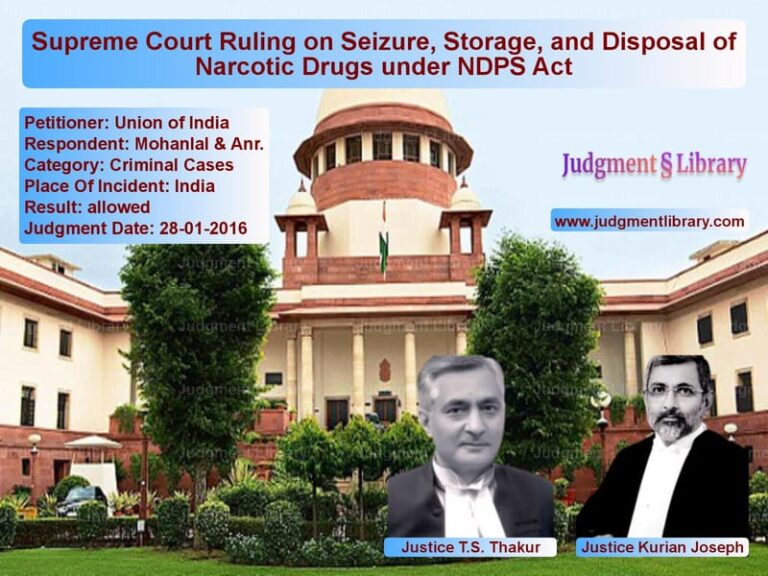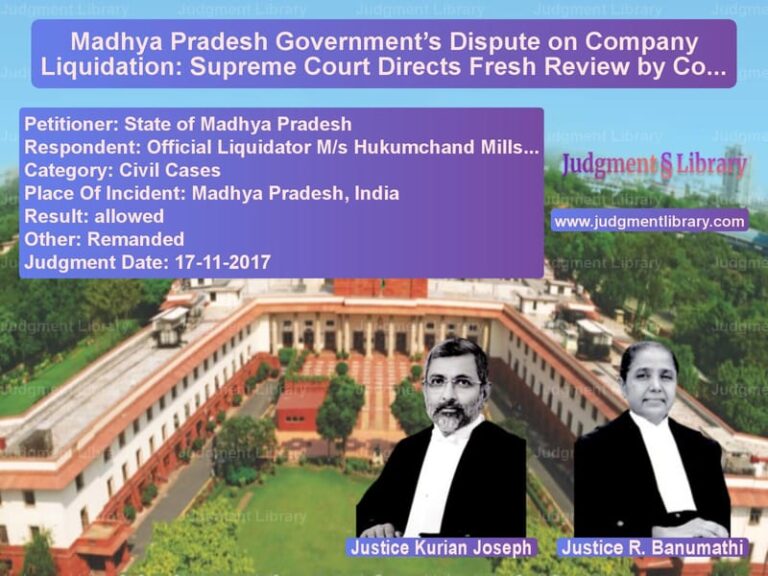Land Acquisition Compensation: Supreme Court Restores Higher Compensation for Farmers
The dispute over land acquisition compensation has been a persistent issue in India, often resulting in legal battles between landowners and acquiring authorities. The Supreme Court of India, in its judgment dated January 31, 2022, addressed one such case where the compensation awarded to farmers was significantly reduced by the High Court. The judgment reinstated the higher compensation originally determined by the Reference Court, bringing relief to the affected landowners.
The case revolves around the acquisition of agricultural land by the Vidarbha Irrigation Development Corporation for the resettlement of affected persons from the Lower Wardha submergence project. The appellants, Madhukar S/O Govindrao Kamble & others, challenged the Bombay High Court’s decision that had reduced the compensation fixed by the Reference Court. The Supreme Court, after reviewing the facts and evidence, found the High Court’s reasoning flawed and restored the compensation initially granted.
Background of the Case
The case pertains to the acquisition of 2.42 hectares of land following a notification under Section 4 of the Land Acquisition Act, 1894, published on February 25, 1999. The Special Land Acquisition Officer had initially fixed the compensation at Rs. 56,500 per hectare. Dissatisfied with this valuation, the landowners sought a reference under Section 18 of the Act.
The Reference Court, upon reviewing the evidence, enhanced the compensation to Rs. 1,95,853 per hectare. However, the Bombay High Court, Nagpur Bench, later set aside this enhancement, reverting the compensation back to Rs. 56,500 per hectare. This led the landowners to appeal before the Supreme Court.
Key Issues in the Case
- Whether the compensation awarded by the Reference Court was justified.
- Whether the High Court was correct in reducing the compensation.
- The relevance of sale exemplars used for determining the market value.
- Consideration of land potential for non-agricultural use in valuation.
Arguments Presented
Arguments by the Petitioner (Landowners)
The appellants argued that the Reference Court correctly evaluated the market value of the land based on sale exemplars and proximity to developed areas. They contended that the acquired land was close to educational institutions, banks, tahsil offices, hospitals, and courts, making it suitable for non-agricultural purposes. The High Court, they argued, had erroneously relied on agricultural land sales for valuation, ignoring the land’s developmental potential.
The counsel for the appellants pointed out that the Reference Court had considered a public auction sale (Exhibit 33) as a relevant example, adjusting the valuation by deducting 30% for non-similarity, 30% for small area considerations, and another 30% for development charges. Despite these deductions, the High Court set aside the enhanced valuation arbitrarily.
Arguments by the Respondent (Vidarbha Irrigation Development Corporation)
The respondents contended that the High Court rightly relied on sale exemplars of agricultural land (Exhibit 31 and Exhibit 32) instead of small-scale auction sales. They argued that the acquired land lacked direct access to roads and did not justify a higher valuation. The respondents also emphasized that using a small plot sale to determine a larger land’s valuation was incorrect.
Supreme Court’s Observations and Judgment
After hearing both parties, the Supreme Court found the High Court’s reasoning flawed. The Court observed that:
- The acquired land was in close proximity to developed areas, including educational institutions, banks, and commercial establishments.
- The High Court wrongly disregarded the Reference Court’s detailed analysis, which had correctly applied appropriate deductions.
- The sale exemplars relied upon by the High Court were of agricultural land without development potential, making them an improper comparison.
The Supreme Court stated:
“The High Court has erred in law in setting aside the determination of market value of the land by the Reference Court.”
Furthermore, the Court emphasized that the market value must be determined by considering multiple factors, including the land’s development potential and proximity to urban amenities. The Court categorically rejected the High Court’s reliance on purely agricultural land sales, stating:
Read also: https://judgmentlibrary.com/supreme-court-upholds-sale-of-parsi-trust-property-in-madhya-pradesh/
“It is not the nature of the land which alone is determinative of the market value of the land. The market value must be determined keeping in view the various factors including proximity to the developed area and the road.”
Final Ruling
The Supreme Court concluded that the Reference Court’s valuation was just and reasonable. It set aside the Bombay High Court’s ruling and restored the compensation of Rs. 1,95,853 per hectare.
The bench, comprising Justices Hemant Gupta and V. Ramasubramanian, delivered the following ruling:
“The reasoning of the High Court is fallacious and not sustainable. Consequently, the appeals are allowed. The order passed by the High Court is set aside and that of the Reference Court is restored.”
Implications of the Judgment
- Reinforces the principle that land valuation must consider development potential and not just current agricultural use.
- Provides relief to landowners who often face undervaluation of their land during acquisition.
- Establishes that deductions applied by Reference Courts in valuation must be respected unless shown to be unreasonable.
Conclusion
The Supreme Court’s judgment in this case upholds the rights of landowners to fair compensation in land acquisition matters. It clarifies that valuation must consider multiple factors, including future potential, and not just current land use. By restoring the Reference Court’s compensation, the ruling ensures that landowners are not shortchanged in government acquisition projects.
Petitioner Name: Madhukar S/O Govindrao Kamble & Ors..Respondent Name: Vidarbha Irrigation Development Corporation & Ors..Judgment By: Justice Hemant Gupta, Justice V. Ramasubramanian.Place Of Incident: Bombay High Court, Nagpur Bench.Judgment Date: 31-01-2022.
Don’t miss out on the full details! Download the complete judgment in PDF format below and gain valuable insights instantly!
Download Judgment: madhukar-so-govindr-vs-vidarbha-irrigation-supreme-court-of-india-judgment-dated-31-01-2022.pdf
Directly Download Judgment: Directly download this Judgment
See all petitions in Property Disputes
See all petitions in Damages and Compensation
See all petitions in Landlord-Tenant Disputes
See all petitions in Specific Performance
See all petitions in Judgment by Hemant Gupta
See all petitions in Judgment by V. Ramasubramanian
See all petitions in allowed
See all petitions in supreme court of India judgments January 2022
See all petitions in 2022 judgments
See all posts in Civil Cases Category
See all allowed petitions in Civil Cases Category
See all Dismissed petitions in Civil Cases Category
See all partially allowed petitions in Civil Cases Category







